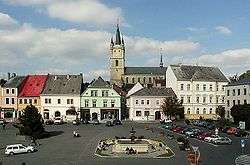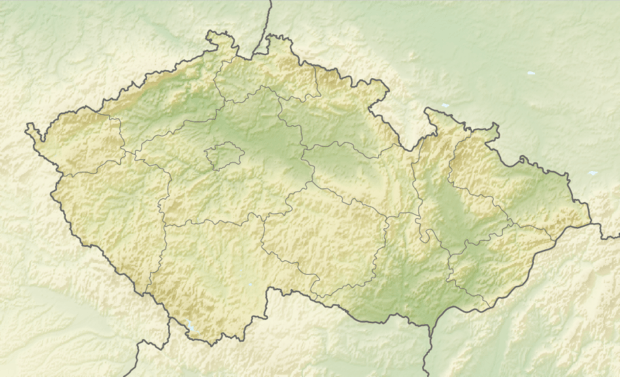Tachov
Tachov (Czech pronunciation: [ˈtaxof]; German: Tachau) is a town in the Plzeň Region of the Czech Republic. It has about 13,000 inhabitants. It lies on the Mže River, some 55 km (34 mi) to the west from the region capital of Plzeň.
Tachov | |
|---|---|
Town | |
 Town square with the Church of the Assumption of the Virgin Mary in the background | |
.png) Flag  Coat of arms | |
 Tachov Location in the Czech Republic | |
| Coordinates: 49°47′43″N 12°37′59″E | |
| Country | |
| Region | Plzeň |
| District | Tachov |
| First mentioned | 1115 |
| Parts | List
|
| Government | |
| • Mayor | Ladislav Macák |
| Area | |
| • Total | 40.85 km2 (15.77 sq mi) |
| Elevation | 483 m (1,585 ft) |
| Population (2020-01-01[1]) | |
| • Total | 13,038 |
| • Density | 320/km2 (830/sq mi) |
| Time zone | UTC+1 (CET) |
| • Summer (DST) | UTC+2 (CEST) |
| Postal code | 347 01 |
| Website | www |
Tachov is also the seat of the Municipality with Extended Competence and the Municipality with Commissioned Local Authority.
History
The area was inhabited by humans around 8,000–6,000 BCE. The first written document mentioning Tachov comes from 1115. King Ottokar II of Bohemia (1233–1278) built a new castle with a massive round stone tower there. He also founded a walled town near the castle.
During the Hussite Wars (1419–1434), the town was several times besieged and conquered. In 1427, Prokop the Great defeated the crusaders near Tachov. The Thirty Years War (1618–1648) damaged the town considerably. In 1664, Count Johann Anton Losy became the new proprietor. The Losy family began conversion of the medieval castle to a large baroque château. In 1784, the title passed to the Windisch-Graetz family. The Windisch-Graetzs, in their turn, rebuilt the house in the classical style at great expense.
Until 1918, Tachov (as Tachau) was part of the Austrian Empire, capital of the district of Tachau, and one of the 94 Bezirkshauptmannschaften in Bohemia.[2]
A post office was opened in Tachov in October 1850.[3]
In 1938, it was occupied by the German army as part of the Sudetenland. Most of the German-speaking population was expelled in 1945 (see the Beneš decrees). The area was only partly repopulated, mostly by Czechs and Slovaks, but also by immigrants from Romania and Ukraine. Later on uranium was mined here, attracting laborers to work in the mines.
After the Velvet Revolution that ended the Communist era in 1989, the uranium mines were closed. Some German companies established factories in the area to make use of the cheap labour. However, the Tachov area is still among the economically least developed Czech regions.
Sights
Town walls
During the 14th century, the town walls were built up around the town. They gradually became a pride of Tachov, especially because of its condition that they are in. In the walls there were three entrances to the town. Thanks to the reconstruction, the walls are very well kept, so even today we can see almost all of the original twenty-four towers, which played an important role during wars and enemy attacks.
Castle
The castle with a cylindrical tower was built up during the reign of Přemysl Otakar II. In 1802 the tower was taken down, and the Windischgrätz family built up the Renaissance castle instead. The construction was finished in 1808 and the Windischgrätzs lived here until 1939. During World War II, the castle was used for civil and military purposes, but it was really ruined, so in 1968 there was the possibility of demolition. Eventually, the castle was saved and from 1969 to 1983 it was under reconstruction. It is now used as The School of Art and also the Municipal Office today, so it is still open to the public.
Church of the Assumption of the Virgin Mary
First it was a Gothic church, but it went through many arrangements during the 14th century. The last reconstruction lasted from 1904–1908 and the church was rebuilt in neogothic style. The inside arrangements come from 1670. It does not have only the classical function of a church. Nowadays there are held many concerts during the year, and it is much – frequented especially during the Christmas time.
Church of St. Wenceslas
It is the oldest church in Tachov and may antedate the town itself. In 1802 the Windischgrätzs bought it and they made it a family tomb. It is a simple building located in park, which replaced a former churchyard. There are still many tombstones of significant burgesses, who lived in Tachov during the 15th – 18th century. In 1947 the Czechoslovakian Hussite Church took over this place.
Franciscan Monastery
The first Franciscans came to Tachov in 1466 and since this year both – the church and the monastery went through many reconstructions. An Italian architect Martino Allio made the first reconstruction in 1686–1694, and the most important one came in years 1745–1750. In 1945 bombs damaged the church and four years later it was closed. Since 1945 it has been used as the County Museum, and it offers information about the history of Tachov and the region surrounding it. The museum is used for many activities and many expositions are held here every year.
Husmann's Mill
The regent Jan Filip Husmann found this baroque mill in 1645. During reconstruction a millwheel was added and at this time it is used by the Cultural Center of the Town and the Tachov's Children Choir.
Jewish cemetery
The cemetery was found in 1615 near the Rapotín Street. The oldest extant gravestones come from the 17th century. Recently STAKUS Tachov made arrangements that should prevent another damaging of gravestones.
Světce
Světce is a complex of three historical buildings. One of them is a monastery built in the 17th century. Josef II cancelled it and so in 1787 the Windischgrätzs bought it and rebuilt it as a castle. The castle, which was finished in 1700 went down, and nowadays we can see only some remain of the walls and a small tower. The last one is a riding hall from the time of romanticism, which was built in 1830. It is the second largest riding hall in Central Europe, right after the Viennese riding hall. Today it is still under a reconstruction and it is not open for the public yet. The only time, when you can visit this place is during the festival, when many concerts are arranged here.
Tachov's surroundings
In the vicinity there are two monuments. One of them is called "Mohyla", which commemorates the death of 232 people, who were killed during the death marches during the World War II. "Vysoká" on the top of ahill another memorial commemorates the Hussite Battle, which took a place in 1427, when the Hussites defeated Crusaders.
Accommodation
The town offers lodging in three 3-star hotels and six pensions.
Notable people
- Franz Joseph Dollhopf (c.1655–1743), philosopher, tenor, organist
- Elias Dollhopf (1703–1773), painter
- Franz Rumpler (1848–1922), painter, acted in Vienna
- Anton Gag (1859–1908), painter
- Reinhold Dollhopf (1875–1963), architect
- Paul Kohner (1900–1965), founder of Kohner Bros., Inc. toy manufacturer – NYC
- Frank Kohner (1910–2011), founder of Kohner Bros., Inc. toy manufacturer – NYC
- Peter Kurzec (1943–2013), writer, acted in Germany
- Míra Sláma (born 1991), bass player of rock band Savage Messiah
References
- "Population of Municipalities – 1 January 2020". Czech Statistical Office. 2020-04-30.
- Klein, Wilhelm. Die postalischen Abstempelungen auf den österreichischen Postwertzeichen-Ausgaben 1867, 1883 und 1890, 1967
- Mueller, Edwin. Handbook of Austria and Lombardy-Venetia Cancellations on the Postage Stamp Issues 1850–1864, 1961.
External links

- Official website (in Czech)
- Tachov (in English)
- Unofficial website with photo gallery (in Czech)
- History
- Portal for this area (in Czech)
